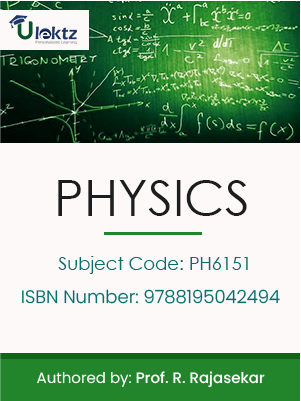

Note: Please check your Spam or Junk folder, in case you didn't receive the email with verification code.
Enter details or overview about the ebook
1.1 Lattice
1.2 Unit cell
1.3 Bravais lattice
1.4 Lattice planes
1.6 d spacing in cubic lattice
1.7 Calculation of number of atoms per unit cell,Atomic radius, Coordination number and Packing factor for SC, BCC, FCC and HCP structures
1.8 Diamond and graphite structures (qualitative treatment)
1.9 Crystal growth techniques ,Solution ,melt (Bridgman and Czochralski)
1.10 Vapour growth techniques (qualitative)
2.1 Elasticity- Hooke's law
2.2 Relationship between three modulii of elasticity (qualitative)
2.3 Stress -strain diagram
2.4 Poisson's ratio
2.5 Factors affecting elasticity
2.6 Bending moment
2.7 Depression of a cantilever:
2.8 Young's modulus by uniform bending
2.9 I-shaped girders
2.10Modes of heat transfer
2.11 Thermal conductivity
2.12 Newton's law of cooling
2.13 Linear heat flow
2.14 Lee's disc method
2.15 Radial heat flow
2.16 Rubber tube method
2.17 Conduction through compound media (series and parallel)
3.1 Black body radiation
3.2 Planck's theory (derivation)
3.3 Deduction of Wien’s displacement law and Rayleigh
3.4 Jeans" Law from Planck's theory
3.5 Compton effect
3.6 Properties of Matter waves
3.8 Schrödinger's wave equation (Time independent and time dependent equations)
3.9 Physical significance of wave function
3.10 Particle in a one dimensional box
3.11 Electron microscope
3.12 Scanning electron microscope
3.13 Transmission electron microscope
4.1 Classification of Sound
4.2 Decibel
4.3 Weber Fechner law
4.4 Sabine's formula
4.5 Absorption Coefficient and its determination
4.6 Factors affecting acoustics of buildings and their remedies
4.7 Production of ultrasonics by magnetostriction
4.8 piezoelectric methods
4.9 Acoustic grating
4.10 Non Destructive Testing
4.11 pulse echo system through transmission and reflection modes
4.12 A,B and C –scan displays
4.13 Medical applications
4.14 Sonogram
5.1 Spontaneous and stimulated emission
5.2 Population inversion
5.3 Einstein’s A and B coefficients & derivation
5.4 Types of lasers- Nd:YAG, CO2, Semiconductor lasers (homojunction & heterojunction)
5.5 Industrial and Medical Applications
5.6 Principle and propagation of light in optical fibres
5.7 Numerical aperture and Acceptance angle
5.8 Types of optical fibres (material, refractive index, mode)
5.9 Attenuation
5.10 Dispersion
5.11 Bending
5.12 Fibre Optical Communication system (Block diagram)
5.13 Active and passive fibre sensor
5.14 Endoscope
 No Preview is available for this book
No Preview is available for this book

 Get 100 instant uPoints on the purchase of Rs.100 or above for each order.
Get 100 instant uPoints on the purchase of Rs.100 or above for each order.
CategoriesEngineering Physics

Format PDF

TypeeBook